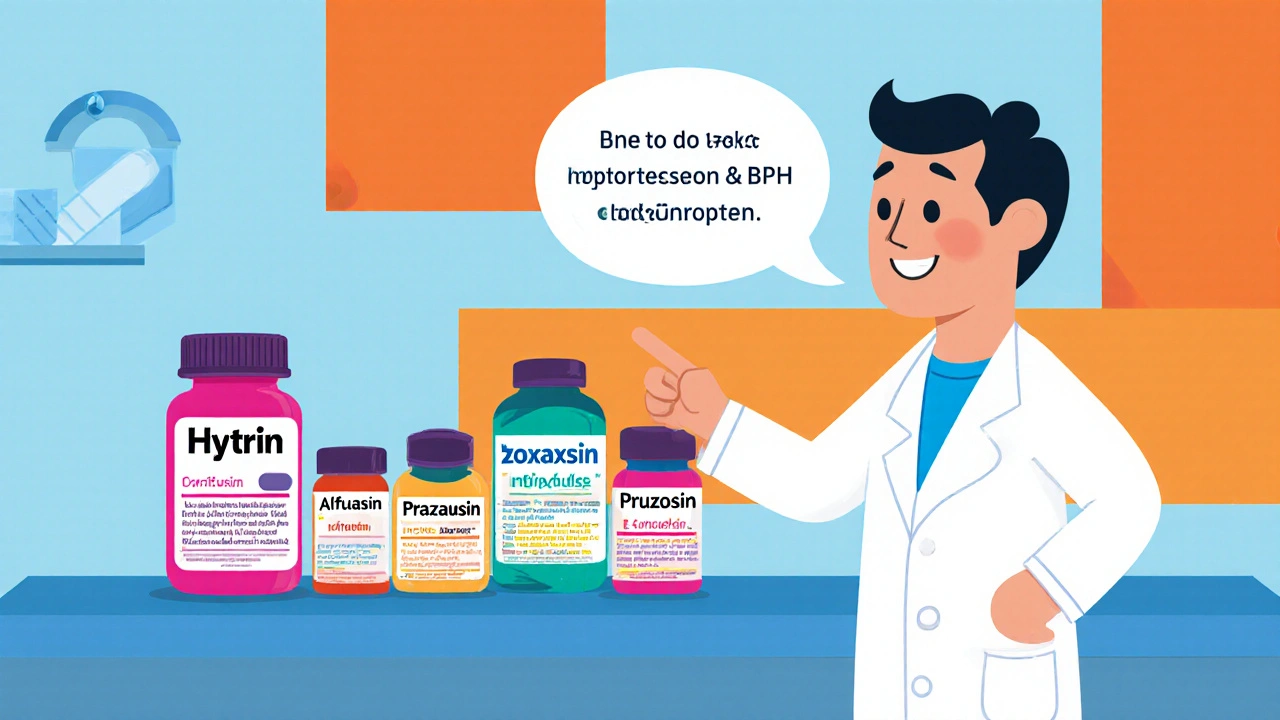Hytrin: What It Is, How It Works, and When It’s Used
When looking at Hytrin, a brand‑name medication that relaxes smooth muscle in blood vessels and the prostate. Also known as Terazosin, it belongs to the alpha‑1 blocker class, which lowers blood pressure by widening arteries and eases urinary flow by relaxing prostate tissue.
Why Hytrin Matters for Hypertension and BPH
Hypertension, a condition where the heart has to push against higher pressure, is a major risk factor for heart attacks and strokes. Hypertension, persistent high blood pressure that strains the cardiovascular system can be tamed with Hytrin because the drug blocks alpha‑1 receptors that keep blood vessels tight. At the same time, many men experience benign prostatic hyperplasia (BPH), an enlargement of the prostate that squeezes the urethra and causes frequent night‑time trips to the bathroom. Benign prostatic hyperplasia, non‑cancerous prostate growth that leads to urinary obstruction benefits from Hytrin’s muscle‑relaxing effect, giving smoother urine flow without surgery.
Because Hytrin hits both targets, doctors often prescribe it to patients who need blood‑pressure control and also have urinary symptoms. This dual action is why Hytrin sits at the crossroads of cardiology and urology, linking two seemingly separate health issues through a single mechanism.
When starting Hytrin, doctors typically begin with a low dose—often 1 mg at bedtime—to let the body adjust. The dose may rise gradually to 5 mg or more, depending on blood‑pressure response and how the prostate feels. Taking the pill at night helps avoid the common side‑effect of dizziness, which can happen when standing up quickly. Patients should monitor their blood pressure at home and keep a symptom diary for urinary changes.
Hytrin doesn’t work in isolation. It can interact with other medicines that also lower blood pressure, such as diuretics, ACE inhibitors, or other alpha‑blockers. Combining two alpha‑blockers—like tamsulosin for prostate issues—can cause an unsafe drop in blood pressure, so doctors usually steer clear of that combo. Over‑the‑counter cold medicines containing decongestants (pseudoephedrine) can blunt Hytrin’s effect and raise blood pressure, making them a risky pairing.
Side‑effects are usually mild but worth watching. The most frequent complaint is orthostatic hypotension—feeling light‑headed after sitting or standing. Some people notice headache, fatigue, or nasal congestion. Rarely, Hytrin can cause a rapid heart rate (reflex tachycardia) or swelling of the ankles. If any of these symptoms become severe, patients should contact their clinician right away.
Recent research explores Hytrin’s role beyond its classic uses. Small studies suggest it might improve sleep‑related breathing problems by relaxing airway muscles, and some urologists are testing lower‑dose regimens for men with mild urinary complaints who don’t need full‑blown blood‑pressure therapy. While these ideas are still under investigation, they illustrate how a well‑known drug can find new niches.
Below you’ll find a curated set of articles that dig deeper into Hytrin’s place in therapy. Whether you’re curious about how Hytrin compares with other alpha‑blockers, want a clear rundown of side‑effects, or need dosing tips for specific health scenarios, the collection offers practical insight you can apply right away.

Hytrin (Terazosin) vs Other Alpha‑Blockers: Detailed Comparison Guide
- Oct, 25 2025
- Daniel Remedios
- 15 Comments
A clear, side‑by‑side comparison of Hytrin (Terazosin) with its main alpha‑blocker alternatives, covering uses, dosing, side effects, and when to switch.
